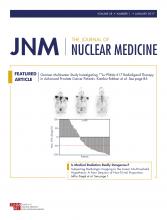REPLY: In their letter, Kwee et al. state that, on the basis of practical advantages and available data, 18FDG PET, not labeled leukocyte imaging, should be the imaging test of choice for detecting prosthetic joint infection. There are indeed practical advantages to 18F-FDG, and I addressed them in the article (1). These advantages, however, are meaningful only if the performance of 18F-FDG is at least comparable to that of labeled leukocyte imaging. Kwee et al. argue that, on the basis of the results of a metaanalysis and recently published data, 18F-FDG is comparable to labeled leukocyte imaging for diagnosing prosthetic joint infection. A review of the literature, however, reveals rather striking inconsistencies in the results reported for 18F-FDG, both alone and in combination with bone or labeled leukocyte imaging. This is in striking contrast to the consistently excellent results that have been reported for labeled leukocyte/marrow imaging over more than 3 decades. Thus, it is difficult to argue convincingly that 18F-FDG is comparable to, and therefore should replace, labeled leukocyte imaging for diagnosing prosthetic joint infection.
There are some additional points that warrant discussion. As Kwee et al. correctly note, I did not address the disadvantages of labeled leukocyte imaging in the article. I assumed, perhaps mistakenly, that after more than 30 y of publications on labeled leukocyte imaging, it was unnecessary to reiterate the already well-known shortcomings of the procedure and that better use could be made of the allotted space.
Kwee et al. suggest that the issue of contradictory results for 18F-FDG was based on one—in their opinion, flawed—investigation (2). To the contrary, contradictory results have been, and continue to be, reported for 18F-FDG alone and in combination with bone or labeled leukocyte imaging. These results, both favorable and unfavorable, were summarized in my article (1).
Kwee et al. attribute the poor results of Love et al. (2) for 18F-FDG to the use of coincidence detection rather than dedicated PET. A careful review of the literature, however, reveals investigations that used state-of-the-art PET or PET/CT to diagnose prosthetic joint infection, and their results for 18F-FDG were no better, and in some cases were less satisfactory, than the results reported by Love et al. (1–4). Consequently, the argument that the data reported by Love et al. (2) are invalid, or flawed, because of the imaging device used is not tenable. Furthermore, this investigation was one of the very few in which the final diagnosis, in all cases, was based on histopathologic and microbiologic specimens obtained at the time of surgery (2).
Finally, Kwee et al. mention that recent consensus guidelines do not include leukocyte/marrow imaging for detecting prosthetic joint infection. One can presume that these guidelines do not include 18F-FDG either, since Kwee et al. do not address this in their letter. According to the most recent revision of the American College of Radiology Appropriateness Criteria on imaging after total hip arthroplasty, labeled leukocyte/bone marrow imaging is the best imaging test for diagnosing infection (5).
In summary, given the inconsistent and at times contradictory results that have been reported for 18F-FDG over more than 15 y of investigation, 18F-FDG—its practical advantages notwithstanding—is not a suitable replacement for labeled leukocyte/marrow imaging for diagnosing prosthetic joint infection. For the moment, labeled leukocyte/marrow imaging is the best imaging test available for this indication.
Footnotes
Published online Sep. 22, 2016.
- © 2017 by the Society of Nuclear Medicine and Molecular Imaging.







